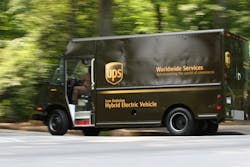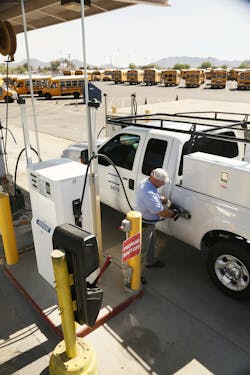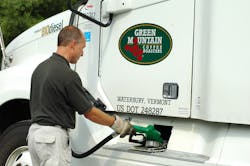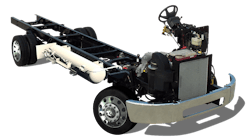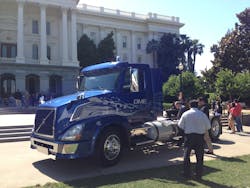Since the dawn of time, it seems, diesel fuel has ruled the landscape for powering commercial vehicles. Sure, every few years a new “fuel of the future” pops up and becomes the darling of the alternative fuel world. Right now, that fuel is natural gas, either in compressed or liquefied form. The benefits of natural gas are many: abundant supply, a domestic fuel, low emissions, almost equivalent power and torque to diesel engines, and low price compared to diesel. Because of this, almost no one believes natural gas will disappear as a fuel; rather, the expectation is it will become the alternative choice to diesel for fleets. Some even suggest that it could someday replace diesel. Of course, just a few years ago, there was significant doubt as to the viability of natural gas as a vehicle fuel—that’s how quickly the alternative fuel landscape can change.
But to suggest that natural gas is now the only choice for fleets looking to get into the alternative fuel arena is to shortchange the other options. There are many, from long-standing choices like propane autogas and biodiesel to the soon-to-be available dimethyl ether (DME) and maybe even hydrogen. And fleets are certainly interested.
An internal Fleet Owner survey of readers found that while only 14% of fleets currently operate any vehicles on alternative fuels, 53% expect more than 30% of their fleet to be operated on alternative fuels within five years and another 20% believe at least 10% of their fleet will be run on such fuels.
Of those fleets running alternative fuel vehicles, nearly half (45%) report that at least 10% of their fleet operates on something other than diesel or gasoline. When asked their level of interest in alternative fuels, 76% responded they had at least some interest in learning more, with 50% saying they were moderately, very or extremely interested.
For fleet managers, then, the question becomes which fuel is right for them? With all the publicity natural gas has been receiving in the last few years, and deservedly so, it is easy to overlook some of the other choices.
“Natural gas is cheap today, but let’s see what happens over time,” says Lewis M. Fulton, co-director of the NextSTEPS program at the Institute of Transportation Studies at the University of California-Davis (UC-Davis). “There is a concern with gas that methane leakage rates are higher than previously understood, affecting its greenhouse gas (GHG) profile, so it could turn out not to be much of a GHG reduction option whereas other technologies might be better for that.
“Other alternative fuels provide a range of benefits, in some cases better than natural gas,” Fulton explains. “For example, biodiesel can be blended into diesel in existing diesel vehicles; electricity can provide emissions-free, quiet operations; hydrogen can do the same over potentially longer driving ranges than electricity. All of these fuels will have some impact on emissions and many will likely have a lower carbon dioxide (CO2) emissions footprint than natural gas.”
While each fuel has its proponents—and critics—what everyone seems to be able to agree on is that fleets will always have plenty of choices.
“No single alternative fuel will be sufficient to meet America’s needs for fuel diversity and environmental benefits in the transportation sector, which accounts for nearly 30% of our energy consumption,” says Jon Leonard, senior vice president of Gladstein, Neandross & Associates (GNA). GNA is the organization behind the yearly Alternative Clean Transportation Expo show, to be held May 5-8 this year in Long Beach, CA. “From light-duty gasoline pickups to Class 8 diesel tractors, alternative fuels other than natural gas can—and should—play important roles for commercial trucking operations.”
Leonard notes that the options for fleets are numerous and include fuels such as E-85 (a blend of up to 85% ethanol and 15% gasoline) and methanol, both of “which offer the advantage of being liquids like gasoline and diesel.”
Supporting success
The success of any one fuel depends on a variety of factors including infrastructure, vehicle platform availability, economies of scale, a fleet’s needs, and cost of the fuel itself. “Viability for an alternative fuel [also] may be determined by regional considerations,” Leonard says. “For example, large fleets like UPS are operating many propane package delivery trucks in Canada, but only a handful have been deployed in the U.S. This difference has largely been due to delays in getting U.S. approval on a propane fuel specification (“HD-5”). However, now that a U.S. specification has recently been approved, UPS seems poised to deploy greater numbers of propane vehicles in its American fleet.”
One issue that affects the success of all the fuel choices is volume. Will there be enough interest in any one option to reduce costs sufficiently to entice fleets to invest in the added infrastructure and vehicle cost premiums associated with the fuels?
“Potential supply of alternative fuels does not seem to be an issue, at least based on what we know today,” Leonard says. “Almost all alternative fuels can be made from America’s plentiful natural gas supply or derived from renewables. There is also enough electrical capacity to phase in battery-electric vehicles, including for significant use in commercial trucking operations. The issue is making alternative fuels cost-effective, and much of that depends on producing them in volumes sufficient to gain economy of scale.”
Once a fleet has made the choice to adopt an alternative fuel, the options can become overwhelming. Looking at similar fleet operations as yours can be a starting point. What fuels are they using? Are they successful? Do they run similar equipment to yours? Similar routes? But as fuel card provider WEX points out, the decision needs to be based on an individual fleet’s needs.
One fuel that many fleets running lighter-class vehicles have seen great success with through the years is propane autogas, so named to differentiate it from the propane used to power cooking grills and heat homes. It’s a tried-and-true fuel, particularly for service fleets. While pickups and vans have traditionally dominated the propane space, Tucker Perkins, chief business development officer for the Propane Education & Research Council (PERC), is particularly excited about opportunities in the package-delivery space as well as other medium-duty applications and even the potential for a propane-powered “Baby 8” tractor at some point.
“You’ll see us making a major in-road in the package delivery [arena] because Freightliner, Ford and Amp [Electric Vehicles] step vans through its Workhorse subsidiary” are all either available today with propane systems or will be soon, Perkins notes. “We’re very, very excited about the adoption rate of the step vans.”
While Ford has had an F-59 stripped chassis and F-650 available with propane for some time (the OEM will launch a propane-powered F-750 in 2015), the introduction of Freightliner Custom Chassis Corp.’s (FCCC) S2G chassis could change the equation for propane. Working with CleanFuel USA, FCCC’s chassis is available with an 8L 325-hp. engine. Like its diesel counterpart, the front-engine S2G utilizes the Freightliner M2 cab, has a gross vehicle weight rating of 33,000 lbs., and comes equipped with an Allison 2300 automatic transmission with PTO provision.
“That moves us into a true 33,000-lb. vehicle and that’s where we think our playground is,” Perkins says. “There’s no range issue. We match diesel or gasoline easily,” and with over 2,700 public propane fueling stations and the ability to easily install a 1,000- or 2,000-gal. tank on-site for fueling, infrastructure and vehicle range is not a concern.
Perkins believes there will eventually be propane used in engines possibly up to 12L for use in Baby 8 tractors due to the fast-advancing technology.
The forgotten fuel
Just a few short years ago biodiesel seemed to be the “it” fuel on the alternative horizon. While it has lost some of its ‘wow’ factor, biodiesel remains a viable—and popular—fuel for fleet applications. Made from a mix of feedstocks that can include recycled cooking oil, soybean oil, and animal fats, trucks running on the fuel typically operate on a blend of between B5 (5% biodiesel) and B20 (20% biodiesel). Some vehicles can run on pure 100% biodiesel. The advantage of biodiesel is that it can be run in existing diesel engines, does not void warranties, and requires no engine modifications, according to the National Biodiesel Board (NBB).
In 2013, the organization reports, the biodiesel industry produced 1.8 billion gals. of advanced biofuels, primarily biodiesel. Navigant Research, which studies global biofuels markets, predicts production growth of 57% by 2022, from 32.4 billion gals. in 2013 to 51.1 billion gals. According to the EPA, biodiesel also offers fleets an opportunity to reduce emissions by as much as 86%. And vehicles in all classes, from automobiles up to Class 8 over-the-road tractors, can use the fuel.
“Biodiesel works well in fleet applications when used in B20 or lower concentrations,” says GNA’s Leonard. “Domestically produced and renewable, biodiesel can substantially reduce many tailpipe emissions including particulate matter; however, biodiesel does tend to increase NOx as blending percentages increase.”
For many fleets, particularly local delivery fleets, hybrid-electric or electric vehicles have been the choice. There are a number of options: hybrid-electric (uses both an electric motor and internal combustion engine to propel the vehicle); plug-in-hybrid electric vehicle, or HEV (plugs into the energy grid for electric power and also utilizes a combustion engine); extended range electric vehicle (operates as a battery electric vehicle for a certain number of miles and switches to an internal combustion engine when the battery is depleted); battery-electric vehicle, or BEV (powered exclusively by an onboard battery plugged into a grid); and fuel-cell vehicle, or FCV (converts energy from fuel such as hydrogen into electricity).
Electric trucks used in urban settings now populate many local fleets. Typically, these are of the battery-electric variety. Smith Electric Vehicles is perhaps the most well-known of the providers, but there are other suppliers as well. The vehicles produce zero emissions, run quietly and can perform most of the same chores as their diesel counterparts. But there are drawbacks, namely vehicle range and the configuration options. Due to the size and weight of batteries needed to power the vehicles and the charging time required, all-electric trucks remain an unrealistic option for many fleets, says Leonard.
“A breakthrough may be needed in storage battery technology before there is mainstream use of battery-electric delivery trucks,” Leonard notes. “However, these vehicles can still work very well in niche applications that are less impacted by the inherent limitations of today’s battery technologies such as limited range or lengthy recharge times for battery packs. In addition, battery-electric trucks offer unique benefits in localities that choose to assign a premium value to zero emissions. Companies like Frito-Lay and UPS have reported positive experiences deploying battery-electric vehicles in applications such as Class 6 delivery trucks operated over relatively short delivery routes.”
BEVs can also offer lower maintenance and lifecycle costs, Leonard says, further improving their total cost of ownership profile. There is also no concern about supply of electricity, according to the Electric Drive Transportation Assn. The association notes that current electricity supplies are sufficient to convert 73% of the U.S. light-duty fleet to electric power, displacing nearly 52% of the nation’s current oil imports.
Best of both worlds
Similar to electric vehicles are hybrid-electric vehicles. These vehicles, which typically include a second fuel source such as gasoline or diesel, include many of the benefits of BEVs without the range limitations. Hybrid-electric vehicles have found their place in applications ranging from medium-duty up to Class 8 tractors.
Even with their success in local delivery, electric and hybrid-electric vehicles will likely remain a small part of the future mix, says UC-Davis’s Fulton. “Electrification of trucks is limited by range requirements. It is not clear how long-haul trucking will be able to operate on electricity, unless catenary system or road-bed inductive charging systems are developed, which is unlikely at least for one to two decades,” he says.
Some fleets have adopted hybrid drive systems, which use hydraulics. These systems typically use an onboard controller to coordinate pumps, hydrostatic motors, and accumulators to power the vehicle during start and stop operations. This is an option for refuse fleets and others who make frequent stops.
There are also plenty of people excited about the future of hydrogen and dimethyl ether, two “new” alternative fuels that have actually been around for quite some time.
Hydrogen is already in use in some applications. It is most commonly seen as a fuel source for city buses, but there are heavy-duty trucks and tractors that operate on the fuel, notably in port operations in California. As a vehicle fuel, hydrogen is usually converted to energy through a combustion engine or via a fuel cell.
The fuel does have its drawbacks, though, including lack of infrastructure, cost of the tanks needed to store it onboard, and the high price of the fuel itself. There is also a limited market at this point for hydrogen vehicles, so economies of scale have not developed, GNA’s Leonard says.
“Hydrogen can be produced from our nation’s diverse domestic resources with the potential for near-zero greenhouse gas emissions,” he adds. “It offers an excellent solution to reduce GHG emissions from transportation applications if the hydrogen is produced in a low net CO2 pathway. When combusted, hydrogen can produce very low criteria pollutant emissions, although some aftertreatment may be necessary to control oxides of nitrogen.”
Range of a hydrogen vehicle is shorter than that of gasoline, diesel and natural gas trucks.
It’s more likely that hydrogen will be incorporated into vehicles in the form of fuel cells. “Vehicles use fuel cells to electrochemically convert hydrogen to provide motive power,” says Leonard. “Fuel cell vehicles typically use hybrid systems with battery packs for peak power and regenerative braking. Fuel cells generate power without exhaust or evaporative emissions, so they are considered to be [zero emission] technology.”
One fleet that is exploring hydrogen fuel cells is FedEx Express. The company is testing 20 electric delivery trucks with hydrogen fuel cell extenders. The pilot is a collaborative effort between FedEx Express, Smith Electric Vehicles and Plug Power, which is supplying the fuel cells.
According to Leonard, the use of fuel cell power and electric drive along with regenerative braking can double the efficiency compared to a hydrogen-only vehicle. Again, cost of the vehicle due to fuel cell stacks and the onboard hydrogen tanks, concerns over the unproven durability of the fuel cell stacks in real-world vehicle use, the high cost of hydrogen fuel, and the lack of hydrogen fueling infrastructure are challenges that are not easily overcome.
California has committed to building at least 100 hydrogen fueling stations to support fuel cell vehicles through the use of fees on motor vehicle and boat registrations and new tires. The program calls for the funding mechanism to exist until 2024. “These various issues will need to be resolved before large-scale commercial implementation of FCVs is possible,” Leonard adds.
The promise of DME
A more near-term solution for fleets may lie in the success of DME. With a high cetane value, DME burns with no particulate matter, offers quiet combustion, and vehicle fueling is similar to propane, which means there is very little infrastructure costs associated with the fuel. It is a gas under ambient conditions with properties similar to propane, according to Oberon Fuels, a San Diego, CA-based provider of DME that is working with Volvo Trucks and Mack Trucks to offer DME-fueled tractors starting in 2015.
While DME is new to North America as a vehicle fuel, it is a chemical that many people interact with on a daily basis. DME is found in aerosol cans and is blended with propane for cooking. As a fuel, it’s been produced and used for years around the world, including China, Japan, Korea and Brazil.
According to Rebecca Boudreaux, president of Oberon Fuels, the fuel can be chemically made from anything that produces methane—food waste, natural gas, landfills, and even animal waste. It also offers plenty of power to drive commercial vehicles of all sizes.
“When you look at DME from a power [standpoint], 1 gal. of DME produces 69,000 Btu,” Boudreaux explains, adding that it takes about 1.88 gal. of DME to equal the power of 1 gal. of diesel. “It’s about comparable to LNG [in terms of power], which I think is around 70,000 Btu. It’s much higher than CNG.”
Diesel-like performance
DME does not require significant changes to the diesel engine, she says. “You start with a base diesel engine and then change out the fuel system, the injectors, fuel pump, and the seals.”
Trucks also do not need a diesel particulate filter to use DME, Boudreaux points out. Oberon notes that DME is price competitive with diesel but not tied to the price of crude, so there is some stability in pricing, and engines using the fuel meet or exceed emissions standards. Because it is compression ignited, it offers high efficiency.
“As we look at it as a transportation fuel, we are looking at storing it on-site where trucks return nightly,” Boudreaux says. A typical on-site dispensing system can pump 30 gals./min from a tank that can hold between 20,000 and 25,000 gals.
“In talking with fleets, alternative fuels have really been a challenge for smaller fleets with varied operations [due to high initial investment],” Boudreaux says. “We see DME as an excellent solution for small, disperse fleets—really for all fleets—but particularly for smaller fleets as a way for them to get into alternative fuels.”
DME-fueled trucks are currently running in a pilot program in Southern California, Boudreaux notes, and they have been delivering “true diesel-like performance.” She sees DME as being a big hit for fleets.
“The comment [from customers] we hear most is if it can do what you say it will, it will be a grand slam,” she says. “We want to be able to compete head-to-head with diesel, and that’s quite a challenge because diesel has a good head start. But we want to be able to compete on price, infrastructure, etc. That’s a grand goal, but that’s what our goal is.”
GNA’s Leonard sees demand of DME and the other alternative fuels as being a crucial factor in their long-term viability as a transportation fuel.
“If there aren’t sufficient numbers of end users deploying vehicles, there will not be adequate ROI for fuel makers to sell a given alternative fuel,” he says. “Demand may be low for many reasons, including competition among alternative fuels. For example, in the heavy-duty trucking sector, DME could become an attractive trucking fuel; as such, it could cut into the demand for natural gas and/or propane as replacements for diesel. It remains to be seen whether there will be enough space in the trucking fuel market to robustly support all three fuels. Ultimately, all fuels will have to compete on cost, performance and environmental impacts.”
Both Leonard and UC-Davis’s Fulton suggest that fleets focus on alternative fuels if they are not already doing so. “Our best advice is to focus on what appears most viable now,” Leonard advises. “In general, very high fuel-use applications will gravitate to alternative fuel options that provide the lowest lifecycle costs; much of this depends on fuel price relative to gasoline or diesel. Over the longer term, it’s difficult to predict winners and losers because things do change; for example, prior to the shale gas revolution, some were predicting the demise of natural gas as a viable transportation fuel.”
Fulton recommends becoming familiar with the fuel options and even incorporating several of them into fleets today. “I think there is an important ‘portfolio’ benefit to fleets to have some vehicles and fuels of these different types in order to hedge against fuel price fluctuations,” he says, “along with just becoming familiar with them so they could make the decision to ‘go big’ in the future. I wouldn’t want to be a fleet with no experience in technology that suddenly becomes dominant five or 10 years from now.”
Regardless of the choice any fleet makes, alternative fuels will remain a piece of the fuel pie, whether it’s through choice or regulation. And fleets need to be ready.
Think before you jump
Fleets considering adoption of alternative fuel vehicles may believe it is a relatively simply decision to make: Do we or do we not make the leap. But it is not that simple, says fuel card provider WEX. There are a multitude of decisions to make beyond the obvious of whether to make the switch and which fuel to use. The company put out a white paper designed to assist fleets with the decision-making process by laying out five best practices every fleet should follow.
The first step, WEX says, is to know the “station coverage” in your operating area. Not all fuels are available in all places, although the firm notes that there are now nearly 12,000 alternative fuel and electric vehicle charging stations in the U.S. Even more impressive is the fact that 82% are accessible by the public.
“It’s important to realize, however, that this network is highly region-dependent,” WEX says in the paper. “For example, the bulk of EV charging stations are located in major metropolitan areas and along the highly traveled Eastern seaboard and West Coast. Significant East-West coverage gaps exist.”
Secondly, WEX advises reviewing the historical pricing of the fuel or fuels you are interested in. One interesting note in the report is that prices of alternative fuels, regardless of the fuel, appear to have been more stable over the past 10 years, while gasoline and diesel have seen more dramatic swings in prices. Not all alternative fuels, though, are cheaper than gasoline and diesel. WEX found that biodiesel, for instance, tends to sell between 10¢ and 40¢/gal. more than diesel and as much as 70¢/gal. more than gasoline.
“Prices are also influenced by station type,” WEX explains. “Private, fleet-only fueling stations can often negotiate lower prices than public retail stations because they can commit to long-term contracts for bulk fuel purchases. This isn’t always the case, however, especially for stations in remote areas or which require smaller quantities of fuel.”
WEX also suggests considering total cost of ownership, not just the cost of fuel, before making an alternative fuel decision. This includes capital costs of equipment, maintenance costs, end-of-life recycling and replacement costs, and indirect costs.
“While it’s true that alternative fuel vehicles and EVs sell at a premium to standard gas-powered ones, the total cost of ownership over the vehicle’s lifetime can be much lower, especially for high-traffic fleets,” WEX says.
Fleets should also seek out tax credits. Many states and federal agencies offer incentives to use alternative fuels. An up-to-date listing can be found at http://www.afdc.energy.gov/laws/.
Finally, fleets need to think about fuel costs “holistically,” WEX says. “Today’s alternative fuel market is a lot like the explosion of home computers in the 1980s or cell phones in the 1990s—lots of types are available, but no clear market winner has yet emerged,” WEX points out in the white paper. “It’s likely to stay that way for some time, perhaps indefinitely. Alternative fuels are a highly decentralized and individualized market. There’s no one-size-fits-all solution.
“Therefore, thinking about alternative fuels as a speculative bet on which option will become ‘the new gasoline’ is an approach that could cost a fleet dearly,” the paper continues. “Instead, it’s more productive to think about which option best suits your fleet’s operational needs and risk profile.”

